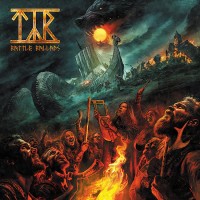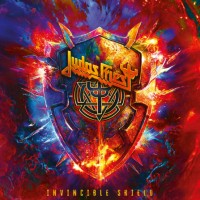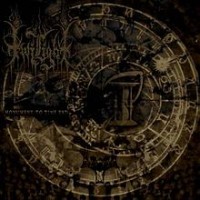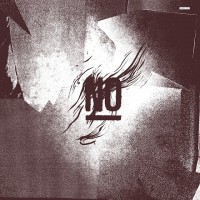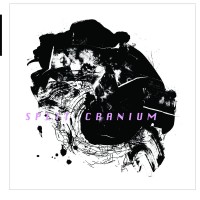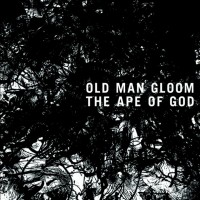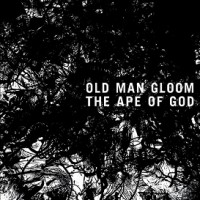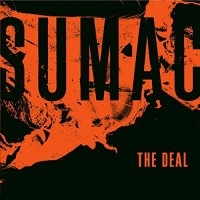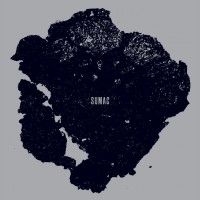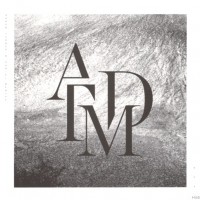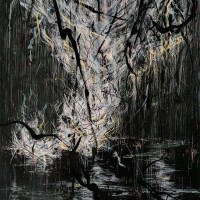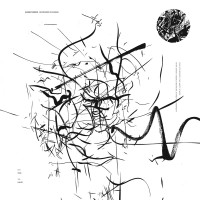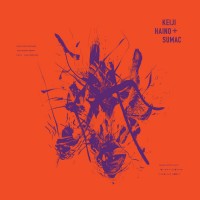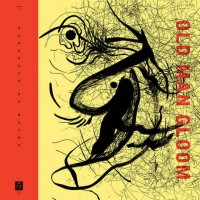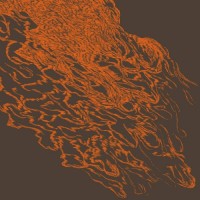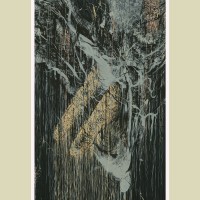Getting Into: Aaron Turner (2010-2020)

| Written by: | RaduP, musclassia |
| Published: | 30.10.2021 |
Click here for Part I.
Matt: The turn of the decade brought about a change in location (Los Angeles to Seattle) and marital status for Turner, tying the knot with Faith Coloccia towards the end of 2009. With one project reaching its conclusion in the form of Isis, the 2010s saw Turner further explore existing projects (Old Man Gloom, Jodis, Mamiffer), start new bands (Sumac, Split Cranium) and extensively collaborate with an array of different musicians, as well releasing music under his own name as a solo artist. It’s a decade of varied, eclectic and experimental music that cemented Turner as a thoroughly unique artist.
Twilight was a supergroup whose lineups have changed quite a bit album to album, so for all three of their albums, the prospect of who was collaborating with who was more interesting than the actual result. 2005’s self-titled has the crème de la crème of USBM together, with the result being good but pretty uninteresting. 2014’s III: Beneath Trident's Tomb answered the question of what would happen if Sonic Youth played black metal, with the result being interesting, but pretty bad. Caught in the middle is 2010’s Monument To Time End, which still feature Krieg’s Imperial, Nachtmystium’s Blake Judd, Leviathan’s Wrest, but joining the black metal team is Minsk’s Sanford Parker, The Atlas Moth’s Stavros Giannopoulos, and the subject of our article. Taking cues from both USBM and post-metal, Monument To Time End is the only Twilight album to be both good and interesting. With such a strong roaster, it’s expected that it would be quite difficult for each member to make a grand mark on the result, with a lot of it sounding like Nachtmystium’s atmospheres transported into Isis’ sludge, mixing darkness and psychedelia in a way, but Wrest’s drumming, Imperial’s throat, and Parker’s space rock synths being pretty impressive too. And with vocal duties shared between Imperial, Turner, and Judd, Turner had a relatively big mark on this one, even if it was the only album where he was a member of the supergroup.
by Radu
With 8 years separating it from Christmas, Old Man Gloom didn’t rush into producing No; the busy schedules of each of the band’s members, whether in Isis, Converge, Cave In or anything else, moved the band into a prolonged period of inactivity. When Old Man Gloom abruptly returned from the void, it was with an album that would effectively encapsulate the band’s core tenets, for better or worse. There’s substantial stretches of ambience and noise across the record, but when the band go hard, they go hard, whether it be the rampaging energy of “Common Species” or the short-but-not-sweet “Regain/Rejoin”. There’s several long songs on this album, and “Shadowed Hand”, “Rats” and “Shuddering Earth” all explore the more esoteric corners of the group’s sludge/noise fusion, with extensive experimental meandering. On the flip side, the album has arguably Old Man Gloom’s most renowned and accessible track, the fiery anthem “To Carry The Flame”; the strength of this song does make me wish Old Man Gloom attempted more straightforward writing in this vein more often, but perhaps the rarity of songs such as this maximize their impact when they do come along.
by Matt

Jodis - Black Curtain (2012)



Black Curtain once again sees Aaron Turner and half of Khanate collaborating under the Jodis moniker to produce Earth-like drone. But compared to its predecessor, Black Curtain doesn’t feel like it still has much in terms of lingering post-metal moments (at least not until the closer), feeling closer to psychedelic drone merged with a touch of slowcore, especially in the clean vocals that touch on ethereal. As a result, there’s parts of Black Curtain that feel more meandering, and while the psychedelic touches are pretty nice, it’s not really evocative often enough to really sustain a mood, but it hits a sweet spot once in a while, and it’s far from a disaster either.
by Radu
Ever wondered what would happen if Aaron Turner and Faith Coloccia got joined by a bunch of Finns and started a D-beat crusty hardcore band? Well, Split Cranium has you covered. Intense, fun, loud, unapologetic. Formed out of Circle joining Isis on their last tour, it’s probably one of Turner’s most direct works. Though that directness is clear on the surface, the album itself is sprinkled with bits of improvisation and experimentation. The free improv noise on “Black Binding Plague”, the backing chants of “Retrace The Circle”, and plenty of other moments that feel left-field even by punk standards. It’s fun to see just how much Turner’s punk energy evolved from his Unionsuit days. Split Cranium did eventually release a follow-up, with the rhythm section replaced and Faith given a bigger role, but it couldn’t properly match the manic energy on display here, and in a way Turner’s vocals somehow didn’t fit as well. Turner and the Finns would end up working again as Turner lended his vocals on a synthwave record of all things on Pharaoh Overlord’s 6.
by Radu
Easily the most obnoxious of Old Man Gloom’s various antics involve The Ape Of God. After distributing a promo copy entitled The Ape Of God to critics, the band ultimately released two albums with the same name and only minute differences in the album artwork color to distinguish them; the promo was comprised of songs from each of the separate records. The main effect of this strategy is to make the circumstances of the albums’ release more prone to discussion than the actual material featured, which is a shame, since both records have plenty of solid material to dig into. The Ape Of God I, or PFL145 (the album catalogue number), has the shorter tracks, which again regularly combine sustained periods of eerie or harsh noise with more energetic sludge or hardcore sections (with “The Lash” really containing an excess of the former). The highlights of this first album include: “Shoulder Meat”, a slow, ponderous, trudging goliath; “Simia Dei”, a percussion-heavy quasi-interlude with a more potent atmosphere than almost any of Old Man Gloom’s other material; and “After You’re Dead”, a challenging but relatively catchy closer.
by Matt
Really highlighting the minuteness of the difference in the packaging of the two records, The Ape Of God II is identified by the number PFL145.5. However, the underlying material is quite different; this album is three minutes longer than its twin, despite featuring only 4 songs to its companion’s 8. With much longer songs, The Ape Of God II pushes closer to post-metal territory; yes, some of those long stretches are noise, but there’s a greater contribution of the metal instrumentation to creating atmosphere and gradually developing tracks, such that, even though it embodies the same primitive nature of all Old Man Gloom records, “Burden” feels more restrained and refined. Hell, there’s even clean vocals on “Arrows Of Our Hearts”. Despite the more protracted songs lengths, The Ape Of God II arguably has the most rewarding balance of metal to ambience, probably because far more of the atmosphere-building on the record is created using metal; as such, I find this record, along with Seminar III: Zozobra, to be the most consistently satisfying release from the band.
by Matt
It probably comes through in my write-ups of Old Man Gloom that I find that project’s music to be somewhat frustratingly inconsistent; however, my qualms with that band are nothing compared with the issues I’ve had with Sumac since its inception. An even more esoteric and experimental project, Sumac was formed by Aaron Turner, Brian Cook (Russian Circles) and Nick Yacyshyn (Baptists and now Genghis Tron), and the trio push the extremes of Old Man Gloom to greater extremes. On the band’s debut, The Deal, stretches of jagged, at-times chaotic sludge were placed alongside extensive stretches of meandering noise. Sumac did manage to relatively frequently hit a reasonable middle ground between these two extremes with some more conventional-sounding post-/sludge metal parts, but the quality of these moments aren’t sufficient to offset the alienation I encounter from the excesses found on the record.
by Matt
Coming shortly after The Deal, What One Becomes showed signs of improvement from Sumac. Yes, aspects of the album were still overly erratic in terms of structure, and there was a lot of inconsistency in terms of the quality across the record (with opening track “Image Of Control (I)” being an unfortunately underwhelming introduction to the album), but there was enough material on this album that actually provided something to get stuck into and enjoy, not least the convoluted groove and off-kilter aggression of “Image Of Control (II)”. What One Becomes isn’t an album that I have an appetite to revisit, but it’s still something I would be fine to sit through if asked to; unfortunately, this turned out to be the peak of my relationship with Sumac.
by Matt
Daniel Menche is a name I seem to run into quite often when reading into ambient drone music, as he is a prominent figure that has been in the scene since the late 80s and continues to release stuff to this day. I first heard about him in his collaboration with John Haughm (ex-Agalloch), so it’s no surprise that he also collaborated with Mamiffer, House Of Low Culture, and, for the first time using his name on a record, Aaron Turner. Nox is quite a bit different than I initially assumed, given how Turner’s ambient collabs usually fare. This is a soundscape meticulously sculptured from synths and voices, and though there are bursts of harmonics that interrupt the droning hums, they feel much better integrated and don’t feel arbitrary. The two artists somehow managed to create something introspective, meditative, bleak, and hypnotic. In its 30 minutes runtime, Nox uses droning repetition, but keeps introducing new layers and elements, making the ambiance heavier and heavier.
by Radu
Aaron Turner and his work in Sumac especially has had a free improvisational aspect to it for a long time, but something tells me that collaborating with improviser extraordinaire Keiji Haino must’ve had some impact on how much that aspect was amped afterwards. I first encountered Haino’s music in the Nazoranai project with Sunn O))) members, and American Dollar Bill is something similar. A lot of the gripes people had with Sumac’s music is the meandering improvisation, and here comes American Dollar Bill being 67 minutes of that. But whereas in a Sumac album, it’s mostly something you wait through to get to the primal sludge, it’s inescapable here. So, in a way, you know what you’re getting into. And working with someone who lives and breathes free improv, it’s here in all its goofy primal unpolished glory. It’s a very unfocused thunderous energy that might not be everyone’s thing (I mean, it sure as hell can come off as pointless and obnoxious), but it’s wilder and more entertaining, despite its runtime. All of the sludge has liquefied into noise rock jamming.
by Radu
One of the more appealing aspects of What One Becomes was the relative brevity of the tracks, which limited the amount of self-indulgence that Sumac could get caught up in. Unfortunately, Love In Shadow went in completely the opposite direction; four songs, ranging from 12 to 21 minutes, all of which feature some good riffs and song progression, but all of which feature stretches that feel directionless and unsatisfying. Surprisingly, the longest song, “The Task”, isn’t the worst culprit; there’s moments where it loses me, particularly towards the end, but rarely does it become a chore. In contrast, closing track “Ecstasy Of Unbecoming” features many of the things that turn me off Sumac: prolonged periods of guitar sustain, structureless guitar noodling, and a lack of coherent progression between the actually enjoyable parts of the song. Love In Shadow isn’t a disaster, but it’s a hard album to recommend to anyone outside of those that actively seek out music that is weird for weird’s sake.
by Matt

Mamiffer - The Brilliant Tabernacle (2019)




Album number five by Mamiffer, The Brilliant Tabernacle is a far cry from the drone-based post rock of the project’s debut. There’s very faint hints of some of Turner’s more weird musical tendencies, such as the noisy guitar towards the end of the opening track “All That Is Beautiful”, but ultimately this album is dominated by the delicate compositional combination of piano, acoustic guitar, flute and Faith Coloccia’s singing, with Jon Mueller’s tom-heavy percussion adding direction and depth to tracks such as “All That Is Beautiful”, “So That The Heart May Be Known” and “Hymn Of Eros”. A far cry from most of the rest of this article, The Brilliant Tabernacle is gentle and charming, and shows Turner contributing to a project with very different musical priorities to those he’s more strongly associated with to great effect.
by Matt
It’s no surprise by now that Aaron Turner likes ambient noise music, the experimental formless kind that barely lies within the realms of music. So much so that the first records to be released solely under the “Aaron Turner” name would be in this style. Repression’s Blossom and Interminable Conniption both fall in the space between 20 and 30 minutes of runtime where they’re kinda EPs, and both of them are pretty impenetrable in intent and execution. I am someone who, while not necessarily enjoying this type of music, does find some appreciation for it. I do respect Aaron Turner for what he’s doing here, and for all intents and purposes, the way he approaches this sound does show some creativity and craftsmanship in the textures, even if the flow is pretty non-existent. But I would not have listened to this, or even taken this seriously, if he wasn’t involved in it. For every moment where “I get it”, it all gets thrown out the window with a random burst of noise right after, hence why “Attar Datura”, the track where this happens the list, almost convinced me to give this an extra half star. Almost. It’s even more frustrating when some of those moments feel like they could’ve been genuinely great if there was any semblance of a focus.
by Radu
American Dollar Bill already had a very live feeling, which is pretty much a given of the nature of the genre, but Even For Just The Briefest Moment is the live album of the two, having been recorded in Tokyo in 2017. It being less of a studio thing obviously means less quality control and a less diverse palette of energy levels. Even For Just The Briefest Moment is less bonkers than its predecessor, which does make the meandering part more hard to bear, and the ones where things do heat up even more impactful. Ultimately, the live environment is precisely what free improv was made for and in which it thrives, so this is exactly the kind of thing I’d love to see live for myself, but wouldn’t care that much to listen to in my own time.
by Radu
Courtesy of another attempt release prank, Seminar IX: Darkness Of Being was somewhat illogically released before Seminar VIII: Light Of Meaning; only the latter was initially announced, but when the Covid pandemic arrived, Old Man Gloom not only revealed that a secret second album was also going to be released, but they also uploaded it a month early to give those trapped in lockdown something to enjoy. Both records follow a similar template, opening with several short cuts (in this case, the saloon piano and relentless stomp of “Procession Of The Wounded” plus a couple of others) before moving onto longer cuts, whether it be the sprawling, at-times seemingly structureless “Canto De Santos”, the lurching “In Your Name” or surprisingly emotional “Love Is Bravery”. The most unusual cut here is “Death Rhymes”, which sees Coloccia join the rest of Old Man Gloom for a stripped-down acoustic song that works surprisingly well given the tone of most of the band’s material. As with most Old Man Gloom records, Seminar IX: Darkness Of Being is somewhat inconsistent, but it does have a strong back stretch.
by Matt
Unintentionally the band’s most recent record at the time of first writing this article, Seminar VIII: Light Of Meaning was going to be Stephen Brodsky’s first outing on record with Old Man Gloom after he filled the void left by Caleb Scofield, who tragically died in a car accident in 2018. Brodsky had played with Scofield in Cave In (indeed, Nate Newton would take on bass duties in Cave In following Scofield’s passing), so was a natural replacement given the close ties between Old Man Gloom, Cave In and Converge. Brodsky also takes on vocal duties on Light Of Meaning, including what I believe are some of his cleans during “Final Defeat”, one of the few instances I can remember of Old Man Gloom incorporating sung vocals into their metal tracks. As I mentioned in the write-up for Darkness Of Being, this record is also structured such that three short songs are followed by three lengthy tracks. In contrast with its companion record, however, Light Of Meaning uses a lot more noise/ambience, with nearly every track featuring substantial stretches of this at both their starts and ends. On the flip side, the actual metal that’s featured is surprisingly conventional for the band, with none of the weirdness of “Canto De Santos” or non-metal of “Death Rhymes”. Seminar VIII: Light Of Meaning is slightly frustrating in how much it is padded out with the dark ambience, but when it gets into its heavy moments, it’s comparable with some of the best work from Old Man Gloom.
by Matt
House Of Low Culture always seemed like an on-and-off thing. A period of activity in 2000-2004, which included Edward’s Lament, covered in Part I. Another one in 2010-2011, which had the project act like a counterpart to Mamiffer mostly. And then, one or two VA contributions. Until now. Well, I’m not sure what to make of Irretrievable, since it’s a one-track album, but one more than 30 minutes in length, and there’s also no way to know when we’re gonna hear from the project again. But as it is, Irretrievable is in a weird spot, being a noisy ambient album (obviously), but one not as impactful as the project’s first stint, not as directionless as Aaron Turner’s solo albums. It’s an ambient album where the noise starts off obnoxious, but starts making more sense as the album goes on, to a point where the atmosphere implodes somewhere in the middle, and it turns into a claustrophobic hum. And then it gets noisy again.
by RaduP
May You Be Held ultimately revealed What One Becomes to be a false dawn; Sumac subsequently showed an attempt to further venture into more esoteric writing. The record is bookended by two extended (semi-)ambient tracks, opening with sparse noise and ringing tone, and closing with very improvisational clean guitar meandering that feels rather directionless and unsatisfying to me. Another track that feels directionless and unsatisfying is “The Iron Chair”, a track that sounds like the musical equivalent of abstract art due to the manner in which it uses distortion and percussion. The approach on “The Iron Chair” and “Laughter And Silence” is so antithetical to anything I enjoy about music that it renders anything else on the album obsolete in terms of me having a positive impression of it; as it is, the two other tracks on the record, the title track and “Consumed”, follow the more standard template the band had established by this point of meshing together menacing mid-tempo sludge, bursts of chaotic intensity, abrasive noise and gradual post-metal-ish progression across extended track lengths, and they do it fairly well, but nowhere near enough to compensate for the more abstract elements of the record. This is an album I could only really recommend to listeners with a strong taste for unconventionality and freeform composition.
by Matt

Summer Of Seventeen - Summer Of Seventeen (2020)




Summer Of Seventeen is one of those rare occurrences of a noise/ambient supergroup, with Aaron Turner and Faith Collacia, being joined by Monika Khot, William Fowler Collins and Daniel Menche. As the title suggests, this one was recorded in the summer of 2017, around the time that the West Coast was set aflame. The sound of impending doomsday was captured to its best extent on this record, and it works so well partly because of how great the chemistry is between these musicians. It being a noise/ambient album it’s a bit hard to discern who contributed what (other than the vocals), but this is something that definitely feels a lot more collaborative and just slightly out of focus. But the result is one of the most brutal ambient records, not brutal in the same way that a harsh noise album is brutal, but with a very heavy and suffocating bass-heavy mood, even if it manages to capture that moment’s weird grandiose beauty as well, especially through the angelic vocals that appear sporadically. With bits of post-rock, industrial and goth rock thrown in, Summer Of Seventeen is on the more dynamic and lively part of the ambient spectrum.
by Radu
Radu: Even as someone who has a taste for the free improvisational ambient noise drone stuff, I find it hard to know how and if to recommend a lot of Turner’s stuff that is in that vein. With the man’s most well received project left behind in the 2000s, Turner’s music became harder to tame. And for a metal site, harder to recommend. So in some of those cases, our low scores for those don’t necessarily mean that the album lacks in quality, but that it’s more impenetrable. Which ironically might be precisely what some others might appreciate about Turner’s music. So don’t avoid our low scores. It might appeal to you. And if it does (and even if it doesn’t), we do invite you to spend some time on Sige Records’ Bandcamp! There’s a lot that we skipped. You’ll find it there.
Hits total: 1806 | This month: 14

